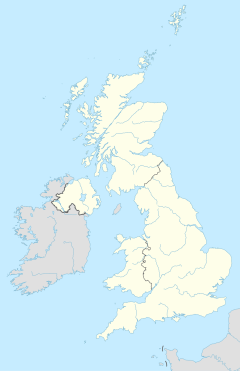Fighting Cocks | |
|---|---|
 An engraving of Fighting Cocks station, from "The Railway Jubilee at Darlington" in Illustrated London News: 340, 2 October 1875 | |
| General information | |
| Location | Middleton St George, Darlington England |
| Coordinates | 54°31′18″N 1°28′21″W / 54.5218°N 1.4724°W |
| Platforms | 2 |
| Other information | |
| Status | Disused |
| History | |
| Original company | Stockton & Darlington Railway |
| Pre-grouping | North Eastern Railway |
| Post-grouping | |
| Key dates | |
| 10 October 1825 | First regular passenger train over Stockton & Darlington Railway; first unofficial use of the station |
| c. 1830 | Official station opened as Middleton and Dinsdale |
| 1866 | Renamed Fighting Cocks |
| 1 July 1887 | Station closed to passengers |
| 1964 | Station closed completely |
 | |
| Location | |
Fighting Cocks railway station was a railway station on the original route of the Stockton & Darlington Railway (S&DR), which served the villages of Middleton St George and Low Dinsdale in County Durham, as well as the once popular Dinsdale Spa Hotel from 1829.
YouTube Encyclopedic
-
1/5Views:49 888495635315420
-
I Bought Filipino Fighting Cocks - Becoming Filipino? 🇵🇭 (Chicken for my Tiny House)
-
Platinum Jubilee 67007 ~ 1Z53 The Fighting Cocks Flyer 23/07/2022
-
43 Squadron The Fighting Cocks / Scotland's History
-
Virtual Walk - Fighting Cocks Pub, Thompson's Garden Centre & Amazon World - Isle Of Wight
-
Cock Lane footbridge 2019 11 13
Transcription
History

When the Stockton & Darlington Railway first opened on 10 October 1825, there were no official stations, as passenger trains were provided by independent coach operators who purchased a licence from the railway company to enable them to operate on the line.[1] Tickets were sold by local publicans, and so it has been claimed that the Fighting Cocks public house, a coaching inn near where the railway crossed Rykeneild Street, could be one of the oldest surviving station booking office in the world.[2] It was not until the success of passenger services on the Liverpool & Manchester Railway persuaded[3] the S&DR to purchase the coach operators that in December 1833 it began to operate its own locomotive-hauled passenger service.[1]
In 1829, the Dinsdale Spa Hotel was opened close to the village of Low Dinsdale, which led to an increase in travel to the village using the railway. As a result, a permanent station was opened during the 1830s (appearing in timetables by 1838), on the east side of the level crossing, to cater for this traffic. It was originally called Middleton and Dinsdale but was renamed Fighting Cocks in 1866.[2]
In 1863 the S&DR was amalgamated into the North Eastern Railway (NER),[4] who on 1 July 1887 opened a new line from south of Darlington Bank Top station to Oak Tree Junction, east of Fighting Cocks station,[5] to enable passenger services on the former S&DR route to serve Bank Top station.[3] However the opening of this new route meant that Fighting Cocks was bypassed, and so a new station was provided at Dinsdale to replace it. Over the course of its life as a passenger station, approximately 30,000 passenger tickets were sold to Fighting Cocks. From this point on Fighting Cocks was only served by goods trains until it was closed completely as an economy measure in 1964.[2]
The line through the station remained as a through line until it was severed at the western end on 21 May 1967,[3] though it was partially retained as a short branch line from Oak Tree Junction until the 1970s.[2]
A public footpath now runs along the alignment of the railway through the site of the station.[6]
References
- ^ a b Tomlinson, William Weaver (1914). The North Eastern Railway: Its Rise and Development. Newcastle-upon-Tyne: Andrew Reid & Co Ltd. pp. 122–127 & 384–385. ISBN 9781296562458.
- ^ a b c d "Making an unremarkable wall truly remarkable | The Northern Echo". The Northern Echo. Retrieved 19 December 2017.
- ^ a b c Hoole, K. (1973). Forgotten Railways: North-East England. Newton Abbot: David & Charles Limited. pp. 142 &151–152. ISBN 0715358944.
- ^ Hill, Norman (2001). Teesside Railways A View From The Past. Hersham: Ian Allan Publishing Ltd. p. 42. ISBN 0711028036.
- ^ Body, Geoffrey (1989). PSL Field Guides - Railways of the Eastern Region Volume 2. Wellingborough: Patrick Stephens Limited. p. 56. ISBN 1852600721.
- ^ "SDR Booklet 6 Darlington to Goosepool via Fighting Cocks 2016-08-03.pdf" (PDF). Friends of the Stockton and Darlington Railway. Retrieved 29 December 2017.
External links
| Preceding station | Historical railways | Following station | ||
|---|---|---|---|---|
| Yarm Line and station closed |
Stockton & Darlington Railway | Darlington North Road Line closed; station open | ||



